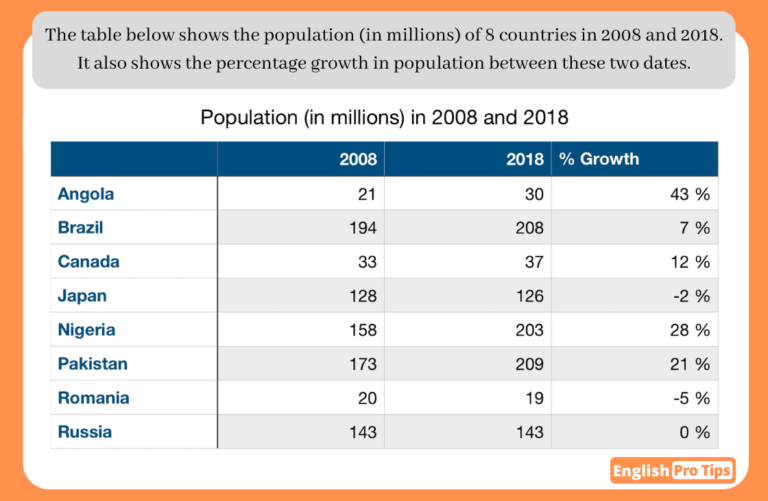How many words should you write in IELTS?
How many words should you write in IELTS?
The instruction in the IELTS writing test say:
Task 1: write at least 150 words
Task 2: write at least 250 words
However, we have found that model answers tend to have many more words than the minimum word count. We challenged three highly experienced IELTS teachers to write a Band 9 model answer to task 1 in 20 minutes. You can read them below.
- Teacher 1: 257 words
- Teacher 2: 270 words
- Teacher 3: 312 words
As you can, all three are way above the minimum word count of 150 words.
It’s not just for Task 1. We looked at our favourite IELTS textbook – IELTS Advantage– and counted the words in their model answers.
- Essay 1: 344 words
- Essay 2: 356 words
- Essay 3: 294 words
- Essay 4: 346 words
- Essay 5: 355 words
- Essay 6: 314 words
Again, all of them are way above the 250 minimum word count.
So, should you be writing more words?
Yes
- More opportunities to develop your answers
- Possibility to diversify your language
No
- Writing quickly often leads to mistakes
- You have to be more careful with your time management. Make sure that you can finish on time.
Ultimately, you’re not going to get a higher or lower score for writing more words. If you have a lot of ideas and the time to finish your answer, go for it! If you find it difficult to finish the test on time, don’t try to write more words just for the sake of it. It’s all about the quality of your answers.
What we recommend
- Practice doing the writing test in one hour. Find out how many words you can write in one hour.
- Learn the common topics in IELTS. This will make it easier to think of ideas quickly in your test.
- Consider doing the writing test. Most people can type more quickly than they can write by hand. It’s also easier to edit your writing.
If you want to learn more about the writing test, check out our Academic Writing Course.
Model Answers

Summarise the information by selecting and reporting the main features, and make comparisons where relevant. Write at least 150 words
The table presents information on the population growth of different countries between 2008 and 2018.
Overall, five countries experienced an increase in population growth (Angola, Brazil, Canada Nigeria and Pakistan), one country (Russia) did not change, and 2 countries saw a reduction in their population figures (Romania and Japan).
Of the five countries that experienced population growth, the largest increase was seen in Angola. This country registered a 43% increase between 2008 and 2018 (from 21 to 30 million). The other African country in the sample- Nigeria- also experienced an increase in population, albeit not as great as Angola’s (28% compared to 43%). Pakistan experienced the third largest growth over the period at 21%. This meant that it became the country with the largest population in the sample of eight countries (with 209 million inhabitants). Further, a rise in population can also be seen in Canada and Brazil, which grew by 12% and 7%, respectively.
Russia was the only country that registered the same number of inhabitants in 2008 and 2018. In each year, the population was 143 million, making it the fourth most populous country in both years.
Both Romania and Japan experienced a decline in their population figures. The greatest decrease was observed in Romania, which saw a 5% decrease between 2008 and 2018 (from 20 to 19 million). It should also be noted that Romania was the country with the smallest population in both years. Finally, Japan saw a modest decrease (2%) in population growth from 128 to 126 million in 2008 and 2018.
Word count: 257
The table illustrates the absolute and percentage change in the population of eight countries between 2008 and 2018.
Overall, there was an increase in five of the eight countries: Angola, Brazil, Canada, Nigeria, and Pakistan. One nation- Russia- did not register a change, and the remaining two countries- Romania and Japan- experienced a declining population over the decade. It is noteworthy that the most considerable growth was in Angola, and the most significant decline was in Romania.
There are three groups of countries: those that increased, stayed the same, and shrunk in population over the ten years. As for the former group, Angola experienced the largest increase, rising from 21 to 30 million (a 43% increase). Nigeria, the other African country in the sample, experienced the second-largest increase (28%). The third greatest increase was observed in Pakistan, which rose from 173 to 209 million in absolute terms, making it the country with the largest 2018 population in the sample. In fourth and fifth place came Canada and Brazil, which grew by 12% and 7%.
In contrast with the above countries are those that did not increase over the period. Russia’s population was exceptional in that it neither rose nor fell over the period; instead, it stayed at 143 million. Romania and Japan, on the other hand, reported a decrease over the years. Romania’s population decreased by 1 million, which given the small size of the population, resulted in a 5% decrease. Japan’s population fell by 2 million, but given that its population was larger than Romania’s in 2008- at 128 million- there was only a 2% decrease in population.
Word count: 270
The table presents data on population shifts across eight countries and ten years, broken down in terms of percentage and absolute change.
In fine, there was a general pattern of population growth across the decade and data presented, with the preponderance of countries listed showing an increase in population ranging from single point movement to strong double-digit growth. Per contra, there were outliers in the sample, including a country’s population in homeostasis and two examples of populations shrinking.
The data can be analysed in two discrete groups: countries where population growth was witnessed, and places without an increase. In terms of the former category, Angola presented the highest proportion of growth, rising from 21 to 30m, thus presenting a 43% increase between the two sample points (2008 and 2018). Whilst this growth is the highest in terms of percentages, it is the second-lowest in terms of absolute growth, only ahead of Canada, the population of which rose from 33 to 37m – a 12% increase, and behind Brazil, which experienced a 7% growth amounting to 14 million additional persons. For the biggest increase in absolute number one must look to Nigeria. The African country’s populace surged from 158 to 203m – an increase of 45 million, which translates to a 28% bump. This is significantly ahead of Pakistan, whose citizenry swelled by more than a fifth (173 to 209m).
Running contrary to the above, there were three examples of countries whose populations didn’t increase over the ten years. Russia was anomalous in that its populace neither rose nor fell, remaining constant at 143m. Japan and Romania were the only countries to report a population decrement, with Japanese denizens falling two million (and 2% overall), and Romania experiencing a population reversal at a rate of one in twenty (starting at 20 million in 2008 and tumbling by a million inhabitants by 2018).
Word count: 312
Be ready for the IELTS test with my IELTS Courses!




